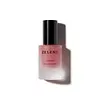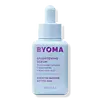Zelens Power B Versus BYOMA Brightening Serum
What's inside
What's inside
 Key Ingredients
Key Ingredients

 Benefits
Benefits

 Concerns
Concerns

 Ingredients Side-by-side
Ingredients Side-by-side

Water
Skin ConditioningNiacinamide
SmoothingPanthenol
Skin ConditioningGlycerin
HumectantPropanediol
SolventPanthenyl Triacetate
Ribose
HumectantSaccharide Isomerate
HumectantPhospholipids
Skin ConditioningChondrus Crispus Extract
Skin ConditioningUrea
BufferingBeta-Glucan
Skin ConditioningApricot Kernel Oil Polyglyceryl-6 Esters
EmollientOrnithine
Skin ConditioningOryza Sativa Extract
AbsorbentBiotin
AntiseborrhoeicGlycolipids
Skin ConditioningAloe Barbadensis Leaf Juice
Skin ConditioningHydrolyzed Hyaluronic Acid
HumectantAvena Sativa Leaf/Stalk Extract
Skin ConditioningChenopodium Quinoa Seed Extract
Skin ConditioningFolic Acid
Skin ConditioningPantothenic Acid
Skin ConditioningPyridoxine Hcl
Skin ConditioningCyanocobalamin
Skin ConditioningSaccharomyces Ferment Lysate Filtrate
Skin ConditioningHydrolyzed Yeast Extract
Skin ConditioningRhamnose
HumectantAdenosine Phosphate
Skin ConditioningGuanosine
Skin ConditioningUracil
Skin ConditioningSodium Hyaluronate
HumectantSaccharomyces/Silicon Ferment
Skin ConditioningSaccharomyces/Copper Ferment
Skin ConditioningSaccharomyces/Iron Ferment
Skin ConditioningSaccharomyces/Magnesium Ferment
Saccharomyces/Zinc Ferment
Skin ConditioningPunica Granatum Seed Extract
Skin ConditioningSilanetriol
Tocopherol
AntioxidantRosmarinus Officinalis Leaf Extract
AntimicrobialLeuconostoc/Radish Root Ferment Filtrate
AntimicrobialXanthan Gum
EmulsifyingSodium Benzoate
MaskingMethylpropanediol
SolventPotassium Sorbate
Preservative1,2-Hexanediol
Skin ConditioningPolyglyceryl-10 Dipalmitate
EmollientDisodium Phosphate
BufferingCitric Acid
BufferingHydroxyacetophenone
AntioxidantAlgin
MaskingBenzoic Acid
MaskingSorbitan Oleate
EmulsifyingSodium Hydroxide
BufferingSorbic Acid
PreservativeLevulinic Acid
PerfumingP-Anisic Acid
MaskingSodium Citrate
BufferingWater, Niacinamide, Panthenol, Glycerin, Propanediol, Panthenyl Triacetate, Ribose, Saccharide Isomerate, Phospholipids, Chondrus Crispus Extract, Urea, Beta-Glucan, Apricot Kernel Oil Polyglyceryl-6 Esters, Ornithine, Oryza Sativa Extract, Biotin, Glycolipids, Aloe Barbadensis Leaf Juice, Hydrolyzed Hyaluronic Acid, Avena Sativa Leaf/Stalk Extract, Chenopodium Quinoa Seed Extract, Folic Acid, Pantothenic Acid, Pyridoxine Hcl, Cyanocobalamin, Saccharomyces Ferment Lysate Filtrate, Hydrolyzed Yeast Extract, Rhamnose, Adenosine Phosphate, Guanosine, Uracil, Sodium Hyaluronate, Saccharomyces/Silicon Ferment, Saccharomyces/Copper Ferment, Saccharomyces/Iron Ferment, Saccharomyces/Magnesium Ferment, Saccharomyces/Zinc Ferment, Punica Granatum Seed Extract, Silanetriol, Tocopherol, Rosmarinus Officinalis Leaf Extract, Leuconostoc/Radish Root Ferment Filtrate, Xanthan Gum, Sodium Benzoate, Methylpropanediol, Potassium Sorbate, 1,2-Hexanediol, Polyglyceryl-10 Dipalmitate, Disodium Phosphate, Citric Acid, Hydroxyacetophenone, Algin, Benzoic Acid, Sorbitan Oleate, Sodium Hydroxide, Sorbic Acid, Levulinic Acid, P-Anisic Acid, Sodium Citrate
Water
Skin ConditioningMethylpropanediol
SolventNiacinamide
Smoothing1,2-Hexanediol
Skin ConditioningGlycerin
HumectantPolyglyceryl-10 Laurate
Skin ConditioningSodium Hyaluronate
HumectantCeramide NP
Skin ConditioningCholesterol
EmollientCaprylic/Capric Triglyceride
MaskingPhytosphingosine
Skin ConditioningSodium Phytate
Ascorbic Acid
AntioxidantStearic Acid
CleansingOleic Acid
EmollientHydrogenated Lecithin
EmulsifyingEthylhexylglycerin
Skin ConditioningXanthan Gum
EmulsifyingSqualane
EmollientTocopherol
AntioxidantLactic Acid
BufferingCarbomer
Emulsion StabilisingTromethamine
BufferingCaprylyl Glycol
EmollientCaprylhydroxamic Acid
Water, Methylpropanediol, Niacinamide, 1,2-Hexanediol, Glycerin, Polyglyceryl-10 Laurate, Sodium Hyaluronate, Ceramide NP, Cholesterol, Caprylic/Capric Triglyceride, Phytosphingosine, Sodium Phytate, Ascorbic Acid, Stearic Acid, Oleic Acid, Hydrogenated Lecithin, Ethylhexylglycerin, Xanthan Gum, Squalane, Tocopherol, Lactic Acid, Carbomer, Tromethamine, Caprylyl Glycol, Caprylhydroxamic Acid
 Reviews
Reviews

Ingredients Explained
These ingredients are found in both products.
Ingredients higher up in an ingredient list are typically present in a larger amount.
1,2-Hexanediol is a synthetic liquid and another multi-functional powerhouse.
It is a:
- Humectant, drawing moisture into the skin
- Emollient, helping to soften skin
- Solvent, dispersing and stabilizing formulas
- Preservative booster, enhancing the antimicrobial activity of other preservatives
Glycerin is already naturally found in your skin. It helps moisturize and protect your skin.
A study from 2016 found glycerin to be more effective as a humectant than AHAs and hyaluronic acid.
As a humectant, it helps the skin stay hydrated by pulling moisture to your skin. The low molecular weight of glycerin allows it to pull moisture into the deeper layers of your skin.
Hydrated skin improves your skin barrier; Your skin barrier helps protect against irritants and bacteria.
Glycerin has also been found to have antimicrobial and antiviral properties. Due to these properties, glycerin is often used in wound and burn treatments.
In cosmetics, glycerin is usually derived from plants such as soybean or palm. However, it can also be sourced from animals, such as tallow or animal fat.
This ingredient is organic, colorless, odorless, and non-toxic.
Glycerin is the name for this ingredient in American English. British English uses Glycerol/Glycerine.
Learn more about GlycerinMethylpropanediol is a synthetic solvent and humectant.
As a solvent, it helps dissolve other ingredients, helping to evenly distribute ingredients throughout the product. This ingredient has also been shown to have antimicrobial properties which makes it a preservative booster.
Methylpropanediol is able to add a bit of moisture to the skin. It also helps other ingredients be better absorbed into the skin, such as salicylic acid.
Learn more about MethylpropanediolNiacinamide is a multitasking form of vitamin B3 that strengthens the skin barrier, reduces pores and dark spots, regulates oil, and improves signs of aging.
And the best part? It's gentle and well-tolerated by most skin types, including sensitive and reactive skin.
You might have heard of "niacin flush", or the reddening of skin that causes itchiness. Niacinamide has not been found to cause this.
In very rare cases, some individuals may not be able to tolerate niacinamide at all or experience an allergic reaction to it.
If you are experiencing flaking, irritation, and dryness with this ingredient, be sure to double check all your products as this ingredient can be found in all categories of skincare.
When incorporating niacinamide into your routine, look out for concentration amounts. Typically, 5% niacinamide provides benefits such as fading dark spots. However, if you have sensitive skin, it is better to begin with a smaller concentration.
When you apply niacinamide to your skin, your body converts it into nicotinamide adenine dinucleotide (NAD). NAD is an essential coenzyme that is already found in your cells as "fuel" and powers countless biological processes.
In your skin, NAD helps repair cell damage, produce new healthy cells, support collagen production, strengthen the skin barrier, and fight environmental stressors (like UV and pollution).
Our natural NAD levels start to decline with age, leading to slower skin repair, visible aging, and a weaker skin barrier. By providing your skin niacinamide, you're recharging your skin's NAD levels. This leads to stronger, healthier, and younger looking skin.
Another name for vitamin B3 is nicotinamide. This vitamin is water-soluble and our bodies don't store it. We obtain Vitamin B3 from either food or skincare. Meat, fish, wheat, yeast, and leafy greens contain vitamin B3.
The type of niacinamide used in skincare is synthetically created.
Learn more about NiacinamideSodium Hyaluronate is hyaluronic acid's salt form. It is commonly derived from the sodium salt of hyaluronic acid.
Like hyaluronic acid, it is great at holding water and acts as a humectant. This makes it a great skin hydrating ingredient.
Sodium Hyaluronate is naturally occurring in our bodies and is mostly found in eye fluid and joints.
These are some other common types of Hyaluronic Acid:
Learn more about Sodium HyaluronateTocopherol (also known as Vitamin E) is a common antioxidant used to help protect the skin from free-radicals and strengthen the skin barrier. It's also fat soluble - this means our skin is great at absorbing it.
Vitamin E also helps keep your natural skin lipids healthy. Your lipid skin barrier naturally consists of lipids, ceramides, and fatty acids. Vitamin E offers extra protection for your skin’s lipid barrier, keeping your skin healthy and nourished.
Another benefit is a bit of UV protection. Vitamin E helps reduce the damage caused by UVB rays. (It should not replace your sunscreen). Combining it with Vitamin C can decrease sunburned cells and hyperpigmentation after UV exposure.
You might have noticed Vitamin E + C often paired together. This is because it is great at stabilizing Vitamin C. Using the two together helps increase the effectiveness of both ingredients.
There are often claims that Vitamin E can reduce/prevent scarring, but these claims haven't been confirmed by scientific research.
Learn more about TocopherolWater. It's the most common cosmetic ingredient of all. You'll usually see it at the top of ingredient lists, meaning that it makes up the largest part of the product.
So why is it so popular? Water most often acts as a solvent - this means that it helps dissolve other ingredients into the formulation.
You'll also recognize water as that liquid we all need to stay alive. If you see this, drink a glass of water. Stay hydrated!
Learn more about WaterXanthan gum is used as a stabilizer and thickener within cosmetic products. It helps give products a sticky, thick feeling - preventing them from being too runny.
On the technical side of things, xanthan gum is a polysaccharide - a combination consisting of multiple sugar molecules bonded together.
Xanthan gum is a pretty common and great ingredient. It is a natural, non-toxic, non-irritating ingredient that is also commonly used in food products.
Learn more about Xanthan Gum